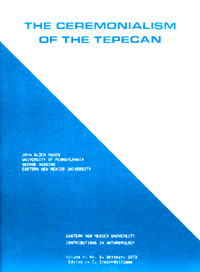
This report is largely the work of Dr. J. Alden Mason. His first name was John, but he preferred to be called Alden. He did the research between 1911 and 1913, and began the report in 1967, as he neared the time of his death. It was unlike the prolific writer — one of the generation of generalists who seemed equally at ease in linguistics, archaeology, or ethnology — to allow the elapse of over half a century between research and publication. I can only surmise that he planned to return to Mexico to do additional work in this area. He no doubt found his professional duties too heavy until after his retirement, when he found his financial position to serious to take time off from his “post-retirement moonlighting” to return to Mexico. Finally after his health declined, he tried to put his scientific files in order but succumbed before the writings of the report was completed. As junior author of this manuscript I believed it necessary to return to Mexico to confirm some aspects of the earlier research. There have been changes, nearly six decades of them. Outside cultural influences have made their impact on the community. Although I had conducted research on the ceremonial activities of the Mayo and Seri of Sonora and the effects of modern witchcults in Chihuahua, my command of Spanish and my knowledge of linguistics provided significant limitations. Therefore, the current study was largely done by my students and the cooperating professional anthropologists of Eastern New Mexico University. Among them were Dr. Alberto Isequilla, research associate for the Paleo-Indian Institute, Eastern New Mexico University, and students, Lynda and Steve Carlotta, who accompanied me to Mexico and conducted most of the Tepecan Field Research at the village of Asqueltan, Mexico. Library research, revision and reorganization were greatly aided by graduate anthropology students, Nancy Charvat-Nagle and Dominique Stevens. Lou Hoffman, Tim McGinnis and Kate Gettys helped to a lesser extent. Steve Carlotta did the photography at Asqueltan. Dr. Ruth Underhill greatly aided the authors of this report with helpful suggestions which were the results of reading the original manuscript before publication. My selection as junior author by Mary Butler and Alfred Kidder, Jr., of the University of Pennsylvania was decided partly on the basis of availability and partly on their knowledge that J. Alden Mason had started me on the road to “fame and poverty” in anthropology.
I was in my early teens when I met J. A. for the first time. It was typical of Dr. Mason that he took an interest in the “high school dropout, with little hope for college” and explained by the hour the secrets of archaeology. I would like to say that he saw me as a rough diamond, but the truth is that he scrutinized me as an unpolished quartz. I have in my possession two Mason letters, one requesting that I be considered as a preparator at the university Museum. Its contents revealed my interest in archaeology. According to the letter, I was a hard and willing worker, but a person with little professional potential. Year later, after I had achieved my doctorate, he wrote another recommendation pointing out how pleased he was with my academic progress and urged that I be hired as an institution of higher learning except one with a society emphasis. In brief, he conceded that I might actually be a diamond but still poorly faceted. Finally, after my post doctoral year at Harvard University, the last reservation was dropped from his kind, accurate, and frequent recommendations in my behalf.
I owe Dr. Mason a geat deal. he never complained when I, as a frequent teenage visitor, took obviously valuable time with countless anthropological questions. I feel had I left him along this report might have been completed many years ago. No only did he sacrifice his time but shared his company, inviting me to his Philadelphia suburban home in Berwyn on numerous occasions. He also kindly introduced me to such greats as Franz Boas, Herbert Spindler, A.V. Kidder, Sr., Ernest Antevs, Clyde Kluckhorn, Ernst Hooton, and George Vailant, at a time in my life when I couldn’t appreciate the honor or understand the importance of these greats to the field of anthropology.
Of this group, A.V. Kidder, Sr., and Ernst Antevs, along with Alden Mason, provided the basic recommendations necessary in my early research years for grants from the Wenner-Gren Foundation, the National Geographic Society, and the American Philosophical Society.
My professional life began at about the same time Dr. J. Alden Mason’s declined. I gave blood for a major operation he under went just before his retirement from the University of Pennsylvania Museum. In retirement he had hoped to complete, at leisure, many projects such as this manuscript, but his financial situation forced him to accept several temporary archaeological assignments at the expense of finishing early uncompleted manuscripts. Dr. John Alden Mason was never a teacher. He was a research curator. As a result he had few protŽgŽs. But, he included as his two most important Dr. S. Ronald Mason, the Paleo-Indian archaeologist, and myself. I feel this is probably the greatest honor that I have ever received in anthropology. — George A. Agogino, 1972
George Agogino’s Forward to “The Ceremonialism of the Tepecan,” John Alden Mason (of University of Pennsylvania), Eastern New Mexico University Contributions in Anthropology, Vol. 4, No. 1, October 1972. (Ed., C. Irwin-Williams).
Last updated by Alice M. Agogino, 31 September 2000